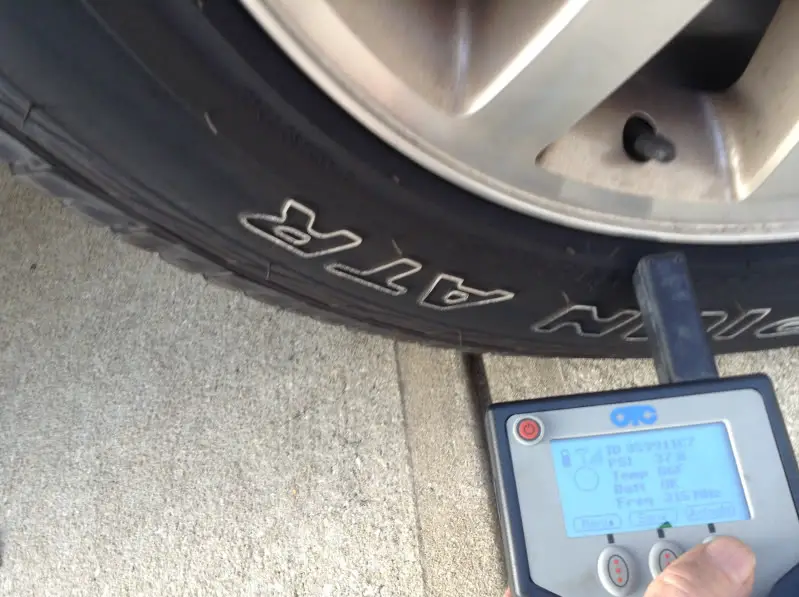Are you experiencing an F150 tire pressure sensor fault? Maintaining proper tire pressure is crucial for both safety and performance. An F150 tire pressure sensor system monitors tire air pressure and alerts you to any deviations.
There can be a problem with the battery or physical damage to the tire pressure sensor on the F150. Faulty wiring, swapping the built-in rim, and fluctuations in temperature are also responsible. These problems mean that the sensor cannot send accurate data and the tire pressure alarm remains on.
Don’t worry, if you are looking for a solution, this is the right place.
Common F150 Tire Pressure Sensor Problems
The tire pressure sensor problem in F150 is a serious problem like tire pressure sensor problems in Jeep or any other vehicle. But the common F150 tire pressure sensor problem is the tire pressure sensor alarm going off in the dashboard.
Sometimes you will find that the tire pressure sensor alarm blinking as well. Now, before you try to fix the tire pressure sensor, you need to confirm that everything else is working.
Conduct the following diagnosis first:
- Check if all the tires are mounted and inflated properly
- Ensure that the F150’s wheel and tire assemblies are identically sized
- Check to see if all tires have functioning TPMS sensors
- Investigate the TPMS sensor’s connectivity to the vehicle’s TPMS module
Once you complete the verification process, it’s confirmed that the tire pressure sensor is causing the problem.
Normally, the tire pressure sensor alarm remains on when the tire pressure sensor controlling module finds an error. This error can be either sending incorrect pressure data or no data at all. When the module detects this error, it turns on the alarm.
Why Do F150 Tire Pressure Sensor Faults Occur?
The tire pressure sensor problem takes place for different reasons such as battery problems, signal interference, and false relearn.
Physical Damage:
Tires can get bolts or any other debris in them. So, this is the most common reason why a tire pressure sensor shows faulty data. Over time the sensor gets exposed to road debris, corrosion, and general wear and tear. All of these take a toll on the quality of the tire pressure sensor.
Low Battery:

The low battery in the TPMS Sensor is another reason for its malfunctioning. These sensors typically have an internal battery that lasts around five to seven years. As the battery ages, its performance decreases, triggering a tire pressure sensor fault warning.
Swapping for Aftermarket Rims:
Swapping stock rims for aftermarket ones can potentially lead to issues with your TPMS system. Aftermarket rims may not have the same mounting pattern as the stock ones, despite their similar appearance. Consequently, compatibility problems may arise with your car’s built-in sensors.
Faulty Wiring:
Faulty wiring or damaged connections between the TPMS sensors and the vehicle’s computer system can lead to false readings. Inspecting and repairing any damaged wires or connectors can help resolve this issue.
Signal Interference:
Additionally, signal interference can disrupt TPMS sensors, especially when other devices operating on similar frequencies are in close proximity. Radar detectors, smartphones, aftermarket antennas, radios, and transceivers are potential sources of signal interference.
Removing old or unused TPMS sensors and relocating spare wheels can help mitigate this problem.
How to Fix the Tire Pressure Fault Problem?
You can fix the F150 tire pressure sensor fault by replacing or resetting the sensor. Let’s go through each of the processes first.
Reset the Tire Pressure Sensor:

Following is the process of resetting the Tire Pressure Sensor.
Step 1: Start your vehicle and drive it for a minimum of two minutes at a speed of 20 mph. This is to activate the sensors.
Step 2: Find a safe and unobstructed space to access a blower or inflator. Next, turn off the ignition.
Step 3: Switch the ignition to “ON” without starting the engine.
Step 4: Press the hazard light button six times within 10 seconds of turning the ignition to “ON. This will switch the hazard lights on and off three times.
Step 5: When you press the sixth time, your truck will emit a horn noise. This indicates that it is in reset or relearn mode.
Step 6: Your dashboard will display a message instructing you to “Train Left Front Tire.”
Step 7: Complete the left front tire sensor training within two minutes of seeing the message. The tire valve cap should be removed, and the valve core must be pushed until the vehicle’s horn sounds.
Step 8: One honk indicates successful TPMS training. Immediately after the honk, train the next tire.
Step 9: Move clockwise around the vehicle to the right front tire. Then the rear right tire, and finally the rear left tire.
Step 10: After training all four tires clockwise, return to the vehicle. A “Training Complete” message should appear on your instrument console. Confirm this by clicking “OK.”
Step 11:Turn off the ignition to exit the TPMS reset mode, then restart the vehicle.
Step 12: Finally, pump up all the tires to the recommended pressure with a tire pump.
Install and Program New F150 Tire Pressure Sensor
If resetting does not work, you can always replace the tire pressure sensor. Do the following
- Remove the tire and deflate it by removing the valve stem
- Use a tire changer to break the bead loose and then remove the tire from the wheel
- Around the valve stem, you will the TPMS Sensor. Find and remove it
- Lubricate and inflate the tire properly
- Balance the wheel and reinstall it back
Just locate the sensor, and then remove the tire. Replace the old pressure sensor with a new one. Then reinstall back the tire into the truck.
Frequently Asked Questions (FAQs):
What to do if the TPMS Light is On After Reinflating the Tires?
To reset the TPMS light after inflating tires, drive at 50 mph for 10 mins. While the car is off, turn the key towards “on” without starting. Hold the TPMS reset button until the light blinks three times, then release it. Start the car and let it run for 20 mins to allow the sensor to reset.
Can I Drive with F150 Tire Pressure Sensor Fault?
Yes, you can drive with an F150 tire pressure sensor fault. But keep in mind about the risks involved. This sensor helps to check and keep track of the tire pressure information. If the sensor is faulty then you will not get any signal when the tire is under-inflated. As a result, you become vulnerable to major risks on the road.
Can I Use a Universal Tire Pressure Sensor on My F150?
Yes, you can use a universal tire pressure sensor on your F150. Consider using universal TPMS sensors, which can replace most sensors in the market. Confirm compatibility with your F150 model. Make sure you choose the correct tire pressure sensor for your F150 model by consulting the owner’s manual.
Conclusion
Therefore, confirm the F150 tire pressure sensor fault. After that, you can go for the diagnosis in detail. Beyond that, keep an eye out for the tire inflation level. Then make sure that the tire is maintained properly. Finally, if you are not comfortable solving the problem on your own, always seek help from professionals.

